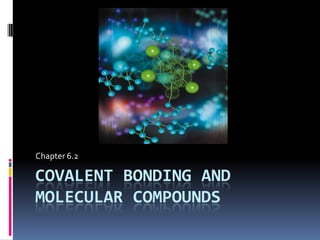
Chapter 6.2 : Covalent Bonding and Molecular Compounds
- 1. Chapter 6.2 Covalent bonding and molecular compounds
- 2. Objectives: Define molecule and molecular formula. Explain the relationships between potential energy, distance between approaching atoms, bond length, and bond energy. State the octet rule List the six basic steps used in writing Lewis structures. Explain how to determine Lewis structures for molecules containing single bonds, multiple bonds, or both. Explain why scientists use resonance structures to represent some molecules
- 5. Shows the types and numbers of atoms combined in a single molecule of a molecular compound
- 6. H2O CO2 C12H22O11
- 8. Molecule containing only two atoms
- 10. Attractedto each
- 11. Decrease in potential energy
- 12. At the same time, both nuclei and two electrons
- 13. repel each other
- 15. The energy required to break a chemical bond and form neutral isolated atoms
- 16. As the bond energy increases-
- 19. The eight electrons come from the main-group energy levels being filled.
- 22. Hydrogen – forms bonds where it is surrounded by only two electrons
- 23. Boron - has just 3 valence electrons, so it tends to form bonds in which it is surrounded by six electrons
- 24. BH3 H B H H
- 25. Electron-Dot Notation Electron-configuration notation in which only the valence electrons of an atom of a particular element are shown, indicated by dots placed around the elements symbol Dots – valence electrons Symbol – nucleus and inner-shell electrons I 7 Valence electrons 53 protons 73 neutrons 36 inner shell electrons
- 26. Electron-Dot Notation First three rows of periodic table Group 1 2 13 14 15 16 17 18
- 28. Pair of electrons that is not involved in bonding and that belongs exclusively to one atom
- 30. Indicates the kind, number, arrangement, and bonds but not the unshared pairs of the atoms in a molecule
- 31. Single Bond –
- 32. Covalent bond produced by the sharing of one pair of electrons between two atoms.B F B – F
- 33. Draw the Lewis Structure of iodomethane, CH3I 1. Determine the type and number of atoms in the molecule 1 C 3 H 1 I 2. Write the electron-dot notation for each type of atom in the molecule C H I 3. Determine the total number of valence electrons in the atoms to be combined C 1 x 4e-= 4e- H 3 x 1e- = 3e- I 1 x 7e- = 7e- 14e- Total valence electrons
- 34. 4. Arrange the atoms to form a skeleton structure for the molecule. IfCarbonis present, it is the central atom. Otherwise, the least-electronegative atom is central (except for hydrogen, which is never central). Then connect the atoms by electron-pair bonds. H H C I H 5. Addunshared pairs of electrons so that each hydrogen atom shares a pair of electrons and each other nonmetal is surrounded by eight electrons H H C I H 6. Count the electrons in the structure to be sure that the number of valence electrons used equals the number available. Be sure the central atom and other atoms besides hydrogen have an octet. 14 e- so this is correct!!!
- 36. Covalent bond produced by the sharing of three pairs of electrons between two atoms N N N N OR
- 37. Draw the Lewis Structure for methanal, CH2O, which is also known as formaldehyde. 1. Determine the type and number of atoms in the molecule 1 C 2 H 1 O 2. Write the electron-dot notation for each type of atom in the molecule C H O 3. Determine the total number of valence electrons in the atoms to be combined C 1 x 4e-= 4e- H 2 x 1e- = 2e- O 1 x 6e- = 6e- 12e-
- 38. 4. Arrange the atoms to form a skeleton structure for the molecule. IfCarbonis present, it is the central atom. Otherwise, the least-electronegative atom is central (except for hydrogen, which is never central). Then connect the atoms by electron-pair bonds. H H C O 5. Addunshared pairs of electrons so that each hydrogen atom shares a pair of electrons and each other nonmetal is surrounded by eight electrons H H C O 6. Count the electrons in the structure to be sure that the number of valence electrons used equals the number available. Be sure the central atom and other atoms besides hydrogen have an octet. H H C O H H C O OR 14 e- = 12 e- SO
- 39. Resonance Structures Bonding in molecules or ion that cannot be correctly represented by a single Lewis structure. O O O O O O Or